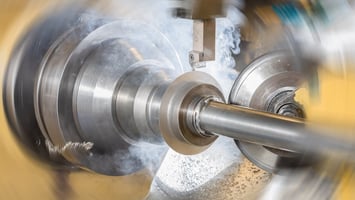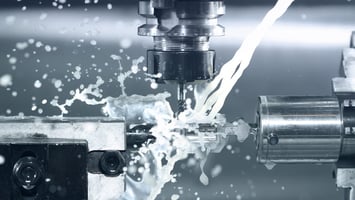Manual and CNC lathes are essential equipment when it comes to machine shops or metal fabrication...
Kryton Metals Blog
Understanding Metal Spinning: Conventional vs. Shear Forming

Metal spinning is a common metallurgy process that turns a blank workpiece into an axially symmetrical part or component with a hollow inside. Machinists use lateral force to press rollers into their workpieces on a high-speed spinning mandrel. The result is a tailored shape that can be used in countless applications.
That’s because spun metal doesn’t lose its material volume or density during production. Instead, the workpiece is subjected to both compressive and tensile forces to achieve the desired effect. And while certain types of metals may react differently to spinning or sustain a minimal decrease in thickness, the overall characteristics of the finished product are indicative of this less invasive machining method.
What is Metal Spinning Used For?
Also known as spin forming, metal spinning is usually performed by hand or with an advanced CNC lathe, and it’s one of the most beneficial methods when rounding metal components for practical and/or decoration purposes. However, in many large-scale metal fabrication projects, the lathe can become automated. In turn, that helps to accommodate precision, consistency, product complexity, and lead time specifications.
In fact, metal spinning is often the preferred machining technique for a wide range of manufactured products, from common household goods and durable cookware to specialty instruments and aerospace parts. Meanwhile, nearly any ductile metal can be spun by skilled hands, including high-strength alloys. That’s why you’ll find spun metals in modern architecture, innovative art, contemporary lighting, and countless public amenities.
DID YOU KNOW: Despite the frequently interchanged name, conventional metal spinning and shear forming are two entirely different CNC machining processes.
Metal Spinning vs. Shear Forming
Whether the blank is flat or a preformed metal sheet, it’s important to understand the differences between conventional metal spinning and shear forming. Metal spinning involves the use of a mandrel and hand or CNC lathe to shape a workpiece, while shear forming involves the use of two rotating disks that shear the workpiece into a specific shape—without the use of a mandrel.
Let’s dive a little deeper:
Conventional Metal Spinning
Conventional metal spinning is a process of shaping a flat metal disk or sheet by using a tool called a mandrel, which rotates at high speed while the metal is pressed against it with a roller or other tool, creating a hollow, symmetrical part.
The workpiece depth thereby increases as the diameter is reduced, making conventional metal spinning one of the simplest and most affordable tooling techniques available.
Shear Spinning/Forming
Shear spinning, also known as shear forming, is a metal spinning technique that involves stretching a metal workpiece over a mandrel using high-pressure rollers. Unlike conventional metal spinning, shear forming reduces the thickness of the material while also reducing the diameter of the workpiece.
Shear forming requires more precise machining and tooling structures than conventional metal spinning, and it generates more heat during the process, requiring cooling to be implemented. Be sure to ask your machining team which coolants are best for the metals and processes you’re using.
Common Types of Spun Metal
Nearly any ductile metal can be spun, but some metals may be more challenging to spin due to their physical properties, such as hardness or ductility. In those cases, specialized techniques may be required to achieve the desired result. Additionally, the thickness of the metal being spun can also affect the ease of the spinning process, with thinner gauges generally being easier to spin than thicker gauges.
The most common metals, included some precious metals, that can be spun are:
- Titanium
- Aluminum
- Bronze
- Copper
- Steel
- Stainless Steel
- Brass
- Hastelloy
- Gold
- Silver
Because this machining technique is primarily used to fabricate hemispheres, parabolas, venturis, cylinders, and cones, it’s generally reserved for expert CNC machinists, skilled artisans, and experienced hobbyists with proper training and equipment who know how to manipulate metals according to their innate properties. In turn, a unique design emerges despite the obvious benefits and drawbacks of the process.
It should be noted that while nearly any ductile metal can be spun, there may be limitations based on the size and shape of the workpiece being spun, as well as the machinery and tools available. Additionally, some metals, such as those with low melting points, may be more difficult to spin due to the heat generated during the process.
The Pros and Cons of Metal Spinning
Not only is metal spinning an ideal machining method for prototype design and innovative product development, but it also involves the following advantages and disadvantages:
Pros
- The entire metal blank is used to create the finished product, resulting in minimal waste and lower material costs.
- Spun metal projects typically produce less waste than conventional metal forming methods.
- Overall tooling costs are relatively low compared to other machining methods.
- The technique is cost-effective and can help shorten lead times for small-to-medium production runs.
- Metal spinning is a simple and efficient manufacturing process that can be used for innovative product development.
Cons
- Surface irregularities or imperfections may occur during the spinning process, which could affect the quality of the finished product.
- Depending on the specifications and tolerances of the part, some parts may fail inspection due to imperfections.
- Consistent product quality can be difficult to achieve with this method, as it depends on the skill and expertise of the machinist.
- Machining conditions for each part must be carefully controlled in order to ensure the best possible outcome.
NOTE: If you’re controlling spun materials in a CNC machine shop, be sure to check the offsets to determine the best machining conditions for each part.
Start Your Project Today
Metal spinning is a quick and convenient way to transform raw materials into usable products for a variety of industries, and it’s one of the most affordable fabrication methods available as well. However, the process can be extremely complicated and dangerous, which means expert CNC machinists are always essential. Wondering if metal spinning might be right for your project? Contact KRYTON today.



